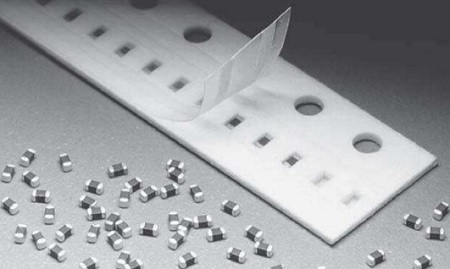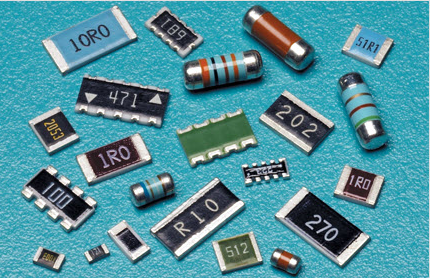Position:Home » Industry News
Miniature future for passive electronic components – Resistors
Writer:Microhm Page View:Date:2019-09-16
Passive electronic components are getting smaller, but they are also providing better performance within the same form factor. Twenty years ago form factors such as 1812 and 1206 were widely used. Today’s most commonly specified sizes are 0603 and 0402. The range extends down to 01005 (0.4 x 0.2 mm), and recently even to just 008004 (0.25 x 0.125 mm!). Microhm Electronics' thick film resistor LMK series and NRC series start with the size 01005. For shunt resistor, the size can be down to 0805.

The trend in SMD (surface mount device) resistors is also toward ever smaller form factors. Wired components are being replaced by this technology wherever possible. The 0201, 01005 and smaller form factors are used primarily in the mobile communications and tablet markets. Resistor networks, like Microhm Electronics LSP seires, also save space on the PCB. And high-power variants deliver twice the performance with the same housing form factor. Further miniaturization is taking place in the SMD current-measuring-resistor segment. New manufacturing technologies are enabling higher load capacities within the same form factor.
Smaller components demand more precise and complex manufacturing techniques, in both fabrication and processing. A further aspect of the smallest form factors is that they are mostly more expensive than the larger sizes used in high volumes.

Below a certain size, the smallest form factors can no longer be replaced when in need of repair, and must be discarded along with the PCB. This can result in more production rejects and electronic scrap in the event of a fault. Smaller – and so more densely packed – PCBs require more stringent protection against ESD, electromagnetic interference, and thermal problems. They often need more interference suppression components. At the same time, small form factors may help suppress interference because they can sit at the source of the interference or load site, reducing unwanted parasitics such as leakage inductance or stray capacitance.
Miniaturization also delivers lighter weight, less of a need for storage areas, and – not least – savings on raw materials. So the trend toward miniaturization is bound to continue.

The trend in SMD (surface mount device) resistors is also toward ever smaller form factors. Wired components are being replaced by this technology wherever possible. The 0201, 01005 and smaller form factors are used primarily in the mobile communications and tablet markets. Resistor networks, like Microhm Electronics LSP seires, also save space on the PCB. And high-power variants deliver twice the performance with the same housing form factor. Further miniaturization is taking place in the SMD current-measuring-resistor segment. New manufacturing technologies are enabling higher load capacities within the same form factor.
Smaller components demand more precise and complex manufacturing techniques, in both fabrication and processing. A further aspect of the smallest form factors is that they are mostly more expensive than the larger sizes used in high volumes.

Below a certain size, the smallest form factors can no longer be replaced when in need of repair, and must be discarded along with the PCB. This can result in more production rejects and electronic scrap in the event of a fault. Smaller – and so more densely packed – PCBs require more stringent protection against ESD, electromagnetic interference, and thermal problems. They often need more interference suppression components. At the same time, small form factors may help suppress interference because they can sit at the source of the interference or load site, reducing unwanted parasitics such as leakage inductance or stray capacitance.
Miniaturization also delivers lighter weight, less of a need for storage areas, and – not least – savings on raw materials. So the trend toward miniaturization is bound to continue.
Keywords:resistor
Latest News
- Resistor's role in measuring and correcting LED,,,
- Single through-hole resistors' characteristics ,,,
- Why shunt resistors for current sense applicati,,,
- Metal-film resistors with small size, high resi,,,
- 36W High-Current Shunt Resistors MMS8420,,,
- 1W Surface Mount Resistor MPR1206,,,
- An Overview of Microhm Electronics' Resistor Pr,,,
- More anti-sulfur resistors used in harsh envir,,,
- Resistance changes with temperature,,,
- 140W TO247 High Power Heatsinkable Resistor,,,
- MMS5930 is ideal for current sensing in industr,,,
- Shunt resistors selection for engineers' design,,,
- Considerations for choosing precision resistors,,,
- Ceramic Encased Cement Resistors NWH Series for,,,
- Resistors for Passive Balancing in Battery-Pow,,,
Hot Articles
- Microhm will take part in 10th Automotive World,,,
- Thanks for Visiting Microhm's Booth E5-5706 in ,,,
- Resistors in Short Supply: Blame Cars,,,
- New lunch: High Power Precision Shunt Resistor,,,,
- How to Test a Resistor,,,
- Innovative Technology, Future Electric: Electri,,,
- What is Precision Resistors?,,,
- SMD Resistors Sizes and Packages,,,
- The Construction and Features of Metal Film Res,,,
- What is a TO-220 Resisor?,,,
- Hot Selling Products: Precision Shunt Resistors,,,
- How to Calculate the Equivalent Resistance Valu,,,
- What is a Fixed Resistor?,,,
- Resistors in LED Circuits,,,
- Resistors Types and Materials Overview,,,
Resistance applications
- Heater Blower Motor Resistor in Air Conditioner,,,
- Shunt Resistor MMS8420 for High Current Stable ,,,
- Industrial Roberts Applied to Solar Photovoltai,,,
- Precision Resistors' Construction and TCR,,,
- Why Zero-Ohm Resistors?,,,
- Carbon Film Resistors' Features and Application,,,
- BMS for New Energy Vehicle,,,
- The Measurement Accuracy of Automotive Shunt is,,,
- The Main Application for High Precision and Low,,,
- Surface Mount Resistor's Size and Package ,,,
- Difference Between High Precision Resistors and,,,
- Miniature future for passive electronic compone,,,
- Select the Right Resistor for Harmonic Filterin,,,
- Urbanization Development Bringing the Transform,,,
- The Four Important Functions of Alloy Resistors,,,
